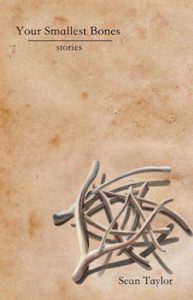
Sean Taylor is one of a group of talented young writers, slam poets, and other performing artists to emerge out of San Francisco’s Open Mic Without A Mic, an outdoor, no-holds-barred performance phenomenon that has played out on late Thursday nights for more than a decade outside the 16th and Mission St. BART station. Many talents (such as NEA fellow Sam Sax and musician Peck The Town Crier) have been incubated in this unlikely setting amid the homeless, the addicts, and the mentally disturbed folk who typically populate this notoriously sketchy intersection where the street meets the Beat.
A few years ago, one of the artists in the crowd (Jonathan Siegel) cobbled together some funds and founded a collective known as Viracocha. It masqueraded as an upscale furniture and design store by day and functioned as an underground artist’s speakeasy (literally in the basement) by night. For a few astonishing years—until this summer, in fact—that basement was host to an incredible number of poetry readings, new music performances, plays, Free University classes, workshops, late night punk-infused Beat-inspired hootenannys, and more. Before it became Viracocha it was the professional work room of a Santeria priestess. I mean, the place has some powerful mojo. The quietly observant, soft-spoken Mr. Taylor was there almost every night, tending bar and composing his stories.
That is where we met, and that is how I became a fan of his first book, Everything to Do with You (read my review here), which was published by Seventh Tangent Press before he reached his twenty-fifth birthday. His second, recently published book, Your Smallest Bones (also from Seventh Tangent, another offshoot of the miracle on 16th St.), has attracted a fair amount of attention. The dedication reads: “For Viracocha.” Like the first collection, these stories are heavy on mood, atmosphere, and character, and light on plot. While the earlier collection featured stories that were almost short enough to qualify as flash fiction, the new stories are longer and richer, but still feature Mr. Taylor’s distinctive, poetic voice. These pieces are like prose poem character studies, reflections on moments of intimacy.
The opener, “Flight and Weightless,” is typical of Taylor’s style. Told in the first person, the story is a free wheeling meditation by a narrator remembering a girl he loved and how she died. After he has left her in Spokane to move to San Francisco, she sends for him. She is dying of cancer. Her last wish is that he and she push a grand piano (she has located one in a shed behind their high school) out onto a lake where surely the ice will crack. She will sit at the piano and play until the lake swallows them both, piano and player. What the reader retains from the story is not so much the plot as the gorgeously observed images. Describing the young couple and the piano on the lake, Taylor writes:
When we got to the middle we were tiptoeing with a grand piano like a pair of professional circus thieves, the legs now sharpened from the spinning slide across like ice skates.
In the same story, the girl tells how, as a pianist, her favorite bones are the smallest ones: the little bones of her hands with which she makes music. Later, she confides that the death-dealing cancer is in her bones. So the bones of the collection’s title are the tiniest, hidden parts of us, the things that hold us up. The smallest bones are also the tiny observations with which Taylor constructs these extraordinary pieces.
One more example: In “Ten Fingers Ten Toes” the narrator remembers a childhood incident when he broke his thumbs. In recalling his mother he writes:
Anyway, I was thinking about mom’s smile and the thing about it was she never went three dimples when she smiled anymore. After saying, be careful, she totally only went one and a half, maybe two dimples when she smiled, the obvious easy dimples, the ones she didn’t have to work for.
The dimples we have to work for, like the piano skating on the ice, is a nourishing image that sticks to one’s ribs.
Taylor’s stories are full of poetry and unforgettable characters: a lonely lady who keeps a bird, an aging married couple who met when they both committed stealth art in a museum, a widow who can’t forget the taste and smell of her late husband’s beloved jalapeno peppers. These pieces inhabit a peculiar space between story and reverie, between plot and timeless observation. Taylor constructs his effects with the tiniest of telling observations.
The result is lovely.





